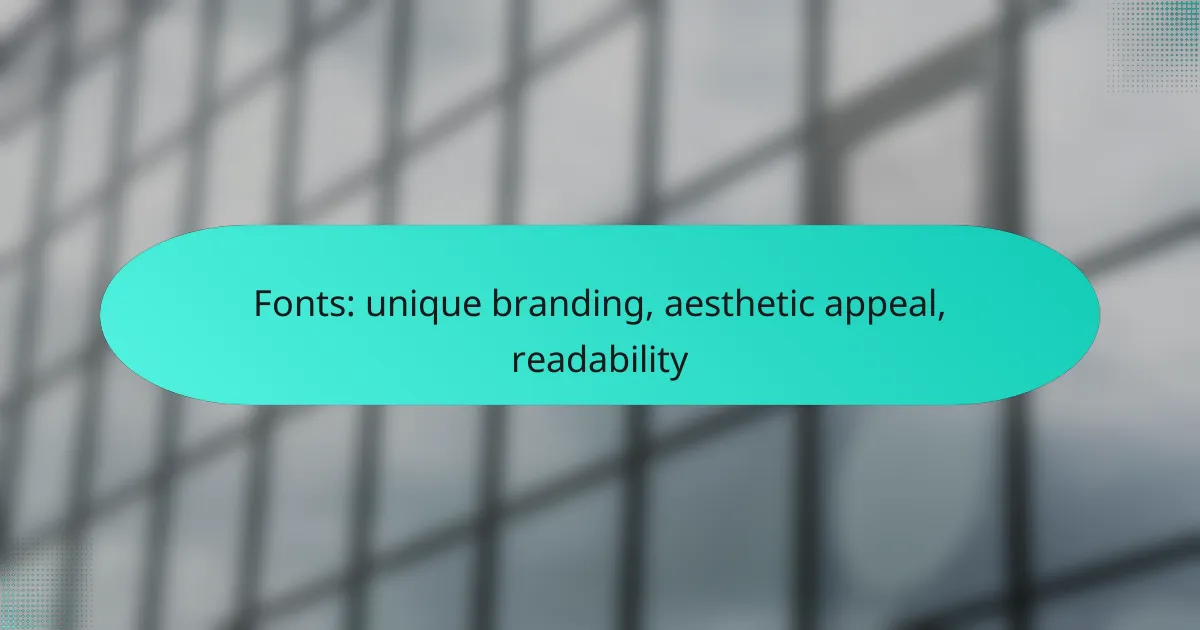Fonts are essential in shaping unique branding, as they reflect a brand’s personality and values through their visual identity. A well-chosen typeface not only enhances aesthetic appeal but also ensures readability, making it easier for audiences to engage with the content. By carefully selecting fonts, brands can create memorable impressions while effectively communicating their message.

How do fonts enhance unique branding?
Fonts play a crucial role in enhancing unique branding by conveying a brand’s personality and values through visual identity. The right typeface can evoke emotions, create recognition, and differentiate a brand in a crowded market.
Brand identity through typography
Typography is a key element of brand identity, as it reflects the essence of a brand’s character. For instance, a luxury brand may opt for elegant serif fonts to convey sophistication, while a tech startup might choose modern sans-serif fonts for a clean, innovative look. Consistency in font usage across all platforms reinforces brand recognition.
When selecting fonts, consider how they align with your brand message. A playful brand might use rounded, whimsical typefaces, whereas a serious brand may prefer bold, straightforward fonts. This alignment helps create a cohesive brand experience that resonates with the target audience.
Case studies of successful brands
Many successful brands have effectively used fonts to enhance their identity. For example, Coca-Cola’s distinctive script font is instantly recognizable and evokes feelings of nostalgia and happiness. Similarly, Google’s use of a simple, sans-serif font reflects its commitment to accessibility and modernity.
Another example is Airbnb, which uses a custom typeface that embodies warmth and friendliness, aligning with its brand mission of belonging. These case studies illustrate how thoughtful font selection can significantly impact brand perception and consumer connection.
Font selection and brand perception
The selection of fonts can significantly influence how consumers perceive a brand. Research shows that certain fonts can evoke specific feelings; for instance, serif fonts are often associated with tradition and reliability, while sans-serif fonts are linked to modernity and cleanliness. This perception can affect consumer trust and loyalty.
When choosing fonts, consider your target audience and the emotions you want to evoke. Avoid overly trendy fonts that may quickly become outdated, and instead, opt for timeless designs that can adapt as your brand evolves. A well-chosen font can enhance your brand’s credibility and appeal, making it essential to invest time in this decision.

What are the best fonts for aesthetic appeal?
The best fonts for aesthetic appeal combine visual attractiveness with effective communication. Fonts that are well-designed can enhance brand identity and create a memorable impression while being easy to read.
Popular aesthetic fonts
Some widely recognized aesthetic fonts include Serif fonts like Times New Roman and modern Sans Serif fonts like Helvetica. Script fonts such as Pacifico and decorative fonts like Lobster are also popular for their unique styles. Each of these fonts can evoke different emotions and set distinct tones for various projects.
Trends in font design
Current trends in font design emphasize minimalism and versatility, with many brands opting for clean, sans-serif styles that are easy to read across digital platforms. Additionally, custom fonts are gaining traction, allowing brands to establish a unique identity. The use of variable fonts, which adjust weight and style dynamically, is also becoming more common.
Impact of font style on visual appeal
The style of a font significantly influences its visual appeal and can affect user perception. For instance, bold fonts can convey strength and confidence, while lighter fonts may suggest elegance and sophistication. Choosing the right font style can enhance the overall aesthetic of a design and improve user engagement.

How do fonts affect readability?
Fonts significantly impact readability by influencing how easily text can be processed by readers. Factors such as style, size, and spacing contribute to overall clarity, making it essential to choose fonts that enhance comprehension and user experience.
Readability standards for digital products
Readability standards for digital products often emphasize the importance of clear typefaces that facilitate quick understanding. Common guidelines suggest using sans-serif fonts for online content due to their clean lines and legibility on screens. Popular choices include Arial, Helvetica, and Open Sans.
Additionally, adhering to established readability metrics, such as the Flesch-Kincaid readability tests, can help ensure that the text is appropriate for the target audience. Aim for a reading level that matches your users’ comprehension abilities, typically around the 8th-grade level for general content.
Font size and spacing recommendations
For optimal readability, font size should generally be set between 16 and 20 pixels for body text on websites. This range helps ensure that users can read without straining their eyes. Headings should be larger, typically 1.5 to 2 times the body text size, to create a clear hierarchy.
Line spacing, or leading, should be at least 1.5 times the font size to prevent text from feeling cramped. Adequate letter spacing can also enhance readability, especially in larger text blocks. A good rule of thumb is to increase letter spacing by 10-20% for larger font sizes.
Accessibility considerations in font choice
When selecting fonts, accessibility should be a top priority. Choose typefaces that are easy to read for individuals with visual impairments, such as those with dyslexia. Fonts like Open Dyslexic or Arial can improve readability for these users.
Ensure sufficient contrast between the text and background colors to enhance visibility. The Web Content Accessibility Guidelines (WCAG) recommend a contrast ratio of at least 4.5:1 for normal text. Additionally, avoid using overly decorative fonts that may hinder comprehension, especially for critical information.

What criteria should be used for font selection?
Font selection should prioritize readability, aesthetic appeal, and brand alignment. Choosing the right font involves considering how well it communicates your message and resonates with your audience while maintaining versatility across different mediums.
Evaluating font versatility
Font versatility refers to a typeface’s ability to perform well across various applications, such as print, web, and mobile. A versatile font should maintain clarity and style whether displayed in large headlines or small body text.
When evaluating versatility, consider factors like weight options, style variations, and compatibility with other fonts. A good practice is to select a font family that offers multiple weights and styles, allowing for flexibility in design without sacrificing coherence.
Matching fonts to target audience
Choosing fonts that resonate with your target audience is crucial for effective branding. Different demographics may respond better to specific styles; for instance, a modern sans-serif may appeal to younger audiences, while a classic serif might attract a more traditional crowd.
To match fonts effectively, research your audience’s preferences and cultural associations. Conducting surveys or focus groups can provide insights into which fonts evoke the desired emotional response. Always consider the context in which the font will be used, as this can significantly influence audience perception.

How to implement fonts in digital products?
Implementing fonts in digital products involves selecting typefaces that align with your brand identity while ensuring readability across devices. It requires careful consideration of font pairing, size, and accessibility to enhance user experience.
Tools for font integration
Several tools can help you integrate fonts into your digital products seamlessly. Google Fonts and Adobe Fonts offer extensive libraries of web-safe fonts that are easy to implement with just a few lines of code. Additionally, CSS frameworks like Bootstrap provide built-in typography options that simplify the process.
For more advanced needs, consider using font management software such as FontBase or Glyphs, which allow for better organization and customization of your font collection. These tools can help streamline the workflow, especially for larger projects.
Best practices for web typography
When implementing fonts, prioritize readability by choosing typefaces that are legible at various sizes. A common guideline is to use a minimum font size of 16px for body text to ensure comfort during reading. Pairing a serif font for headings with a sans-serif font for body text can create a visually appealing contrast.
Maintain consistency by limiting the number of different fonts used across your product. Typically, using two to three typefaces is sufficient. Additionally, ensure that your font choices are accessible; consider color contrast and line spacing to enhance legibility for all users.

What emerging trends are shaping font design?
Emerging trends in font design focus on enhancing user experience through improved aesthetics, functionality, and adaptability. Key developments include the rise of variable fonts, which offer flexibility and customization, as well as a growing emphasis on accessibility and readability across various platforms.
Variable fonts and their benefits
Variable fonts are a single font file that contains multiple styles, weights, and widths, allowing for greater design flexibility. This technology reduces the number of font files needed, which can improve website load times and overall performance.
One significant benefit of variable fonts is their adaptability to different screen sizes and resolutions. Designers can create a more cohesive brand identity by adjusting font characteristics dynamically, ensuring readability across devices without sacrificing aesthetic appeal.
When implementing variable fonts, consider the balance between design and performance. Use them to maintain brand consistency while optimizing for speed, and avoid overly complex variations that may confuse users. A good rule of thumb is to limit the number of styles used to a few key variations that align with your brand’s voice.
